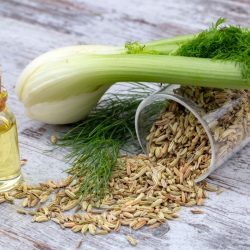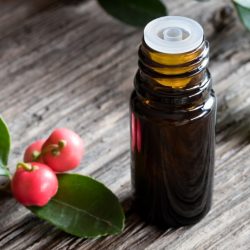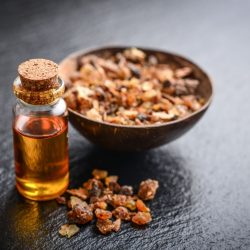To fully understand the sacred dimension that surrounds this basil, it is important to retrace its steps, and to go to its original land, that is to say India. There, basil is just as sacred as verbena was to the Romans, if not more so. Very small “temples” are erected there, as well as veritable altars surrounded by walls and pillars, in honor of this plant to which people address themselves as if it were a divinity .
A little history
Best known for its essential oil, holy basil has been widely used in herbal medicine in the Indian subcontinent for thousands of years, where Ayurvedic medicine has used it both cooked and raw.
Here is how the Hindus conceive their special relation to this plant , according to the observations of the clergyman Vincenzo Maria da Santa Caterina who visited the place in the 17th century: “They take great care of this herb; before her they murmur their prayer several times a day, often prostrating themselves, singing, dancing, sprinkling it with water. On the banks of the rivers where they go to bathe, we see them in great quantity; they believe in fact that the gods particularly like this herb, and that the god Ganavedi(Ganeça) remains there continuously. When they travel, in the absence of this plant, they draw it on the ground with its root, this is how it is explained that at the seaside, we so often notice such figures drawn on the sand ”.
It is true that in terms of gods, the tulasî is linked no less than to Lakshmî and to Vishnu , and this herb encircles the foreheads of many other deities of the Hindu pantheon , knowing that its refined fragrance remains associated to divine power. A fruitful and fertile plant, the tulasi is invoked for the protection of all parts of the human body, from head to feet, and to each of them corresponds a very distinct prayer. The incomparable tulasî intervenes as well for life as for death. It is an immortal plant “which contains within it all the perfections, which ward off the evils, who purifies and guides those who cultivate it to heavenly paradise ”.
What are the pharmacological properties of the essential oil of aerial parts of holy basil?
Antimicrobial and antiparasitic property:
Immunostimulant , the essential oil of holy basil is also antifungal , against Cladosporium herbarum and Penicillium glabrum , against Candida , Aspergillus & dermatophytes (including resistant to fluconazole) by cell membrane damage and leads to a considerable reduction in the amount of ergosterol, a specific component of the fungal cell membrane.
Holy basil is also antibacterial , eugenol is active against Trichomonas vaginalis, Helicobacter pylori, Listeria monocytogenes, Escherichia coli and mycoplasmas (Ureaplasma sp). Its effect is synergistic in combination with antibiotics.
Antiviral against herpes virus, this essential oil is also repellent against Aedes aegypti and anthelmintic by the eugenol it contains.
Analgesic and anti-inflammatory property:
Analgesic by mediated effect of alpha2-adrenergic and opioid receptors, the essential oil of holy basil has a favorable effect in neuropathic pain , neurodegenerative and metabolic diseases .
Ligand for type 2 cannabinoid receptors (CB2), without the psychotropic effects of type 1 cannabinoids (CB1) and natural agonist of endogenous cannabinoid 2 (CB-2) receptors which induce anti-inflammatory effects , holy basil prevents Cisplatin- induced nephrotoxicity (via a CB-2 receptor-dependent pathway) and decreases the cardiotoxicity of doxorubicin by a similar mechanism, making it accordingly of enormous therapeutic potential for a multitude of diseases associated with inflammation and oxidative stress, due to its excellent safety profile in humans.
Anti-inflammatory by inhibiting Cox-2, this essential oil inhibits the synthesis of prostaglandins, in particular by the mucous membrane of the colon. Antiarthritic , it is also a cancer preventive agent. The β-caryophyllene interferes in several signaling cascades causing tumors and would, just as the eugenol , a candidate as a preventive and curative agent for certain types of cancer.
Its immunomodulatory and anti-inflammatory effects can be explained by eugenol, which inhibits the NF-κB pathway.
Property on the central nervous system:
Parasympatholytic and sympatholytic , the essential oil of holy basil is hypotensive by peripheral vasodilator effect. It prevents the reduction of dopamine in the striatum, and prevents lipoperoxidation, which has a potential effect in Parkinson’s disease , as well as neuroprotective in multiple sclerosis .
Anxiolytic , without effect on benzodiazepine receptors, it is a potent antagonist of nicotinic acetylcholine receptors (α7-nAChRs) and devoid of effects mediated by serotoninergic and GABAergic receptors.
Other properties:
- Spasmolytic, anti convulsant
- Antioxidant and DNA protector
- Antiaggregant
- Anti-estrogenic effect
- May help reduce alcohol consumption
- Negative inotropic effect by calcium-blocker effect
Does sacred basil essential oil require any precautions for use?
- Contraindicated in pregnant or breastfeeding women
- Contraindicated in children under 12
- No more than 10 days of use ( risk of mutagenicity and carcinogenicity in the long term and / or in high doses )
- Drug interactions with essential oils containing more than 10% ketones
- Containing phenols and sesquiterpenes, risk of self-toxicity by molecular interactions
- Pure dermocaustic, dilution required
- Caution in case of gastritis and oral ulcer
- Do not diffuse or put in the bath water
- No wet inhalation
- The hepatic metabolization can cause hepato toxicity in the long course or in high doses, it should always be diluted and combined with other well tolerated essential oils, in order to “cut” and reduce its proportion in the final mixture. orally
- Prohibited in animals
Medical bibliographic sources and clinical trials :
- Amber K, Aijaz A, Immaculata X, Luqman KA, Nikhat M. Anticandidal effect of Ocimum sanctum essential oil and its synergy with fluconazole and ketoconazole. Phytomedicine. 2010
- Khan A, Ahmad A, Akhtar F, Yousuf S, Xess I, Khan LA, Manzoor N. Ocimum sanctum essential oil and its active principles exert their antifungal activity by disrupting ergosterol biosynthesis and membrane integrity. Res Microbiol. 2010
- Asha MK, Prashanth D, Murali B, Padmaja R, Amit A. Anthelmintic activity of essential oil of Ocimum sanctum and eugenol. Fitoterapia. 2001
- Saharkhiz MJ, Kamyab AA, Kazerani NK, Zomorodian K, Pakshir K, Rahimi MJ. Chemical Compositions and Antimicrobial Activities of Ocimum sanctum L. Essential Oils at Different Harvest Stages.Jundishapur J Microbiol. 2014
- Upadhyay, RK (2017). Tulsi: A holy plant with high medicinal and therapeutic value. International Journal of Green Pharmacy
- Tawatsin A, Asavadachanukorn P, Thavara U, Wongsinkongman P, Bansidhi J, Boonruad T, Chavalittumrong P, Soonthornchareonnon N, Komalamisra N, Mulla MS. Repellency of essential oils extracted from plants in Thailand against four mosquito vectors (Diptera: Culicidae) and oviposition deterrent effects against Aedes aegypti (Diptera: Culicidae). Southeast Asian J Trop Med Public Health. 2006







